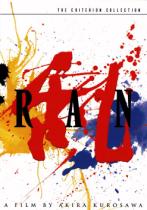Ran
 Year:
Year: 1985
Film Studio: Herald Ace, Nippon Herald Films, Greenwich Film Production
Genre: Drama, Action
Length: 163 Min.
DirectorAkira Kurosawa (1910)
WritingAkira Kurosawa (1910)...Screenwriter
Hideo Oguni (1904)...Screenwriter
Masato Ide (1922)...Screenwriter
ProducerKatsumi Furukawa
Masato Hara
Serge Silberman (1917)
CinematographerAsakazu Nakai (1901)
Takao Saitô (1920)
Shôji Ueda (1938)
MusicTôru Takemitsu (1930)...Composer
StarsTatsuya Nakadai (1932) as Lord Hidetora Ichimonji
Akira Terao (1947) as Taro Takatora Ichimonji
Jinpachi Nezu (1947) as Jiro Masatora Ichimonji
Daisuke Ryû (1957) as Saburo Naotora Ichimonji
Mieko Harada (1958) as Lady Kaede
Yoshiko Miyazaki (1958) as Lady Sue
Hisashi Igawa (1936) as Shuri Kurogane
Peter (1952) as Kyoami
Review Most directors in the twilight of their film careers tend to fall back on the tried and trued formulas that had been successful to them in their youth. John Ford, Howard Hawks and Alfred Hitchcock, names synonymous with the pinnacle of cinematic achievement, had virtually nothing left in the tank in terms of creativity in their later years. Such was not the case in the career of acclaimed Japanese director Akira Kurosawa. His career would rise as a Phoenix from the ashes of exiled obscurity in the late sixties and seventies at the hands of Toho studio executives who did not share in his artistic vision. This hiatus kept buried in his heart, the fire to create in the medium which he had been shutout for so long during those fifteen years.
At the beginning of the eighties, with a little help from Francis Ford Coppola and George Lucas, he returned to the silver screen with the ambitious jidai-geki
Kagemusha. And although it was an international and critical success, Kurosawa still could not get funding for any future films from Toho executives. Finally in 1984, with the backing of a French production company, he secured the funds needed to complete his last great masterpiece,
Ran. Based upon Shakespeare’s
King Lear and modeled after the Sengoku-era warlord Mori Motonari, who successfully divided his clan holdings between his three sons, Kurosawa combined the two stories to reveal what would happen if the three sons were truly bad in character.
Patriarchal warlord Hidetora Ichimonji (Tatsuya Nakadai) has rampaged over feudal Japan for almost a half a century. He has defeated many enemies and taken their land into his clan’s domain. Now in the twilight of his years, he wishes to settle back and allow his sons to reign over his dominion as he peacefully strides towards the end of his life. After a successful hunting trip, he hands each son a single arrow and instructs them to break it in half, which each does rather easily. He then hands his eldest son Taro (Akira Terao) three arrows and repeats his command to snap them. This time, not only Taro but Jiro (Jinpachi Nezu) and Saburo (Daisuke Ryo) find the strength of the combined arrows too difficult to split in half. It is in this exercise that Hidetora proves to each son that alone they can be defeated, but when combined, they are stronger and more likely to come out victorious in battle.
He then informs them of his decision to abdicate his throne to his eldest son Taro, with Jiro and Saburo in support of Taro’s rule. Taro and Jiro both acquiesce to their father’s wishes with false humility. Saburo, on the other hand, sees his father’s design as senile folly. Knowing that Hidetora raised the three sons to be as ruthless as himself, Saburo understands that they will turn on each other when the situation best suits them, and emphatically denounces his father’s edict. Hidetora mistakenly views Saburo’s monition as insolence and disavows himself of his youngest son and banishes him from his holdings, thus setting in motion the resulting betrayals that will turn brother against brother and lay waste to the great Ichimonji clan.
In this, his final masterpiece, Kurosawa would create one of the most visually stunning tragedies ever caught on film. The breadth and scope of detail used in the production are mind-numbing. Battle scenes that rampage over a broad landscape are photographed in a style and manner never since duplicated. The depth and development of each of the major characters is equally engrossing and disturbing at the same time. Only a wizened veteran of storytelling can pull off a film of this magnitude, quality and length and still keep the viewer entranced. Although he would make three more films before his death in 1998,
Ran would be Kurosawa’s swan song, but oh what a lyrical and majestic tune he would scribe. If you’re a true film lover, you owe it to yourself to view this treasure at least once in your lifetime.
Ratings Criterion5 Stars - The pinnacle of film perfection and excellence.4 ½ Stars - Not quite an immortal film, yet a masterpiece in its own right.
4 Stars - Historically important film, considered a classic.
3 ½ Stars - An entertaining film that’s fun or engaging to watch.
3 Stars – A good film that’s worth a Netflix venture.
2 ½ Stars - Borderline viewable.
2 Stars – A bad film that may have a moment of interest.
1 ½ Stars – Insipid, trite and sophomoric, and that's its good points.
1 Star – A film so vacuous, it will suck 2 hours from the remainder of your life.
½ Star - A gangrenous and festering pustule in the chronicles of celluloid.